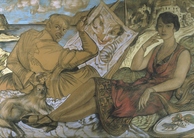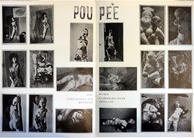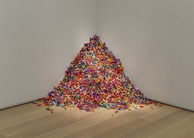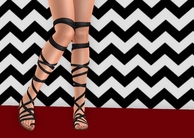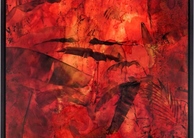Featured Article:Communicating Meaning in BioArt: The Temporal Strength of Living Media and the Impact of Longevity
By
2017, Vol. 9 No. 01 | pg. 2/2 | « V. Reincarnation—The Secret Behind BioArt’s Philosopher’s StoneNot all bioartists (or money-supplying sponsors) are content to let their masterpieces rest in peace, even when presented the option of a glorious funeral. Indeed, some seek to immortalize their work, an idea in tune with the traditional art of yore. However, there is no escaping the fact that living pieces die. Thus, bioartists turn to non-traditional methodologies to preserve their work. Suspended ReanimationFor some BioArt, the preservation process is relatively simple. In several renditions of the Semi-Living Worry Dolls, after the public killing ceremony, the cells were “preserved in glycerol” (Byerley & Chong, 2015, p. 211). With Reodica’s hymNext (2004) project, which artificially grew hymens to deflower the sanctity of virginity, the bioartist “stops their growth” at the desired size “and coats them in latex” (Byerley & Chong, 2015, p. 211). Hertz’s hardware-filled frogs were submerged in jars of mineral oil (Bryant, 2009, p. 144). Duff’s Living Viral Tattoos (2008), which used retroviruses and immunohistochemical stains to tattoo skin cultures, were pickled in “paraformaldehyde fixative” (Duff, 2009, p. 43). However, Duff took things one step further: Even in the modern era of laboratory-equipped museums, she never displayed her art’s physically living forms beyond her lab’s doors. Though Duff acknowledged her final works as “dead and preserved,” she saw the dead bodies as meeting the “threshold of liveliness…documentation [should] be seen, not as representation or interpretation, but as in itself productive of liveliness,” a notion endorsed by famous performance artist Dr. Philip Auslander (Duff, 2009, p. 38). This concept of living documentation challenges the prevalent assumption that audience members must physically see, smell, and hear a BioArtwork and lends credibility to another, more drastic form of preservation. TransmutationMany only know Alba, the GFP Bunny, through second-hand sources. With semi-living and transgenic BioArt, “sell-out shows based on large digital prints of photographs” depicting the biological art are common (Byerley & Chong, 2015, p. 211). Duff’s Viral Tattoos reach mass media through careful video documentation. Stelarc’s Ear on Arm (2007), wherein he surgically implanted an artificially grown ear into his forearm, is immortalized with mock-up plaster ear-and-arm “casts” (Byerley & Chong, 2015, p. 211). TC&A’s Semi-Living Worry Dolls photographs make worldwide rounds.Duff would consider BioArt to include these non-living representations. This method of achieving preservation through transformations in physical media recalls the issue of conflicting BioArt definitions: Does BioArt include works that are about the modification of nature? Catts, co-founder of TC&A, would answer, “Not quite.” While he accepts that a preservation in glycerol (as done with his Semi-Living Worry Dolls) could perhaps constitute BioArt, accepting printed paper as lively goes too far: It defeats the premise of “durational art” (Zurr & Catts, 2004, p. 10). With the NYC MoMA’s solid-state photos of TC&A’s tissue-cultured Pig Wings (1997), Catts regards them as “just the prints” (Byerley & Chong, 2015, p. 211). True BioArt “goes through a living cycle” (Byerley & Chong, 2015, p. 211). Pigs don’t fly if the pig is dead. Acknowledging living documentation as extending BioArtistic longevity may create puppets from carcasses. The time-derived meaning is lost. Only the shell survives. However, a recent story provides a strong counterargument, shaking Catts’s absolutist definition to the core: Kac’s GFP Bunny, oft-regarded as the most popular example of BioArt, “has evidently never actually existed” (Davis et al., 2001, p. 2). Indeed, Kac’s widely “publicized photographs and posters of the white bunny as florescent green” are graphically altered (Davis et al., 2001, p. 2). Houdebine, Kac’s scientist accomplice, has recently stated the “GFP rabbits in his laboratory do not fluoresce bright green because the gene for fluorescence is not exposed in rabbit fur” (Davis et al., 2001, p. 2). It appears that the art-piece that captivated the world, basically inventing the entire BioArt field, is fake. BioArt’s magnum opus is a giant hoax. Or is it? The bunny still contained the GFP gene. The concept of genetically altering the cute and cuddly was still made reality. The photographic prints, Photoshopped neon green, still inspired conversation about biological modification. This game-changing story lends credibility to Duff’s argument about the liveliness of documentation. As proven by the BioArt field’s progenitor, if sufficiently moving, a non-living piece about biotechnology can transcend into a cognitively living existence. BioArtworks can be reincarnated through non-biological mediums. Reproductive TransmigrationHowever, for true creativity, one must step outside the box and make it a tree: BioArtworks can also be reincarnated through another biological vessel. Specifically, some species of BioArt, transgenic collages, can do what other artworks cannot: Reproduce. Art analyst Stracey wonders, “What happens when, or if, it [a BioArt piece] is released into the wild?” (Stracey, 2009, p. 498). When de Menezes modified wing patterns in nature?, she never took away the butterflies’ ability to “carry out a ‘normal’ life” (Stracey, 2009, p. 498). Due to transgenic regulations, the release of fertile modified organisms into the wild is purely conceptual. Still, there are baby steps. In Natural History of the Enigma (2003)—wherein Kac inserted his DNA into a petunia—the flower “will die within a month or two, but the [produced] seeds…should still be good” long after Kac’s death (Byerley & Chong, 2015, p. 209). In a more active example, with the CAE’s Transgenic Bacteria Release Machine (2003), exhibition audiences “were left to decide for themselves…whether they wished to release crippled [sterile] non-pathogenic Escherichia coli bacteria, transformed with DNA fragments, into the environment” (Byerley & Chong, 2015, p. 210). Jeremijenko carves deeper into true transmigration with OneTree (2001), wherein she grew “1000 clones from the same walnut tree,” intending to plant them in different environments to provide active commentary on the nature versus nurture debate (Vaage, 2016, p. 96). While the actual implementation was truncated, “13 pairs” were planted in “the San Francisco area…and living trees remained at 9 of the sites” (Vaage, 2016, p. 96). Though these walnut trees weren’t genetically modified (thus absolving Jeremijenko of any bio-legislative crimes), her art still lives with a potential, albeit extremely small potential, for reproduction. If the gene jar is filled with serendipitous success, reproducing artworks can communicate their messages eternally. Exploring Our Brave New WorldLet’s take things even further with a thought experiment: What if the GFP Bunny—now updated to grow GFP-expressing fur—was taken into the care of Kac as originally intended? What if it was bred with another GFP-modified bunny? It stands to reason the offspring would be considered another work of art. What if this art was released into the wild, the GFP gene proved favorable, and green bunnies became the status quo, the very definition of ultimate artistic longevity? There must be a point when an originally artistic phenomenon is so normalized, so ubiquitous, that it ceases to provoke creative sentiment. Is it still art? What if genes resulting in a forearm ear, a la Ear on Arm, were evolutionarily favored and perpetuated? Art? More realistically, what about a gene modification that provided cancer resistance but caused fluorescent skin-pore secretions? Perhaps the first generation of test subjects would be considered “living art,” but what about when this trait becomes the norm? Art? This longevity-based conundrum can only arise from the unique properties of the temporal BioArt medium. Margaret Atwood’s dystopian novel Oryx and Crake brings our initial thought experiment, a GFP bunny-populated world, into literary reality. Giant, glowing green rabbits—a result of a long-forgotten jellyfish gene experiment—run free through the land, replacing raccoons as the ubiquitous mammalian pest. Cogdell, playing on the same trope but adhering to a brighter brand of futurism, imagines “nongenetically engineered plants such as trees and grass disappear[ing] at the onset of the genetically altered kudzu and ‘enhanced bio-renewable moss,’ the latter of which effectively turns the concrete jungle into a park” (Cogdell, 2011, p. 25). The title of Cogdell’s journal, From BioArt to BioDesign, perfectly embodies BioArt’s Philosopher’s Stone. Creative experimentation, designed to provide social commentary on biotechnology, can spark innovation in corporate America. Artistic ideas can become industrially actualized, culturally mainstream, and eventually, an intrinsic part of human society: True immortalization through integration. VI. ConclusionRomanticist artist J. M. W. Turner was an experimentalist. Splaying the latest and greatest pigments onto his canvases, nobody, especially J. M. W. Turner, knew how long they would last. Some paints live long. Other paints die young. Turner turned a blind eye: Only the lively present matters. BioArt is thematically similar, but possesses one crucial revision: Some BioArtworks live long. Other BioArtworks die young. Bioartists turn their faces forward: The present is important, but true meaning is formed from the intermingling past, present, and future. Like humans, BioArtworks are individually unique: They age, creating new memories and new impressions. Moreover, like Turner’s pigments, each BioArtwork develops differently. This variance in longevity, and the resulting variance in meaning, depends on the factors I discussed: The artwork’s pre-embryonic background, the multivariate maintenance efforts, the orchestrated termination process, and the potential for post-death reincarnation. Further research needs to be done on these stages and their impacts on audience members, as biotechnology is advancing at a breakneck pace. The cutting-edge CRISPR gene-editing tool of today will be hackneyed into the mundane, yet beloved, PCR DNA-cloning technique of tomorrow. Like Turner, bioartists will grab at the freshest tools available to create new messages, new meanings, and new perceptions of reality. We live and breathe alongside Kac’s GFP Bunny, Catts’s Victimless Jacket, and TC&A’s Semi-Living Worry Dolls. Constantly transforming and intrinsically transient, BioArt pieces speak truth through humanity’s beautifully animated, fluidic fourth dimension: Time. ReferencesAnclien, J. J. (2009). Crush Videos and the Case for Criminalizing Criminal Depictions. University of Memphis Law Review, 40, 1–54. Anker, S. (2014). The Beginnings and the Ends of BioArt. Artlink, 34(3), 16. Birke, L. (2009). Meddling with Medusa: On Genetic Manipulation, Art and Animals. In C. Gigliotti (Ed.), Leonardo’s Choice (pp. 107–121). Springer Netherlands. Retrieved from http://link.springer.com/chapter/10.1007/978-90-481-2479-4_7 Bryant, T. L. (2009). Transgenic Bioart, Animals, and the Law. In C. Gigliotti (Ed.), Leonardo’s Choice: Genetic Technologies and Animals (pp. 123–148). Dordrecht: Springer Netherlands. Retrieved from http://dx.doi.org/10.1007/978-90-481-2479-4_8 Byerley, A., & Chong, D. (2015). Biotech aesthetics: Exploring the practice of bio art. Culture and Organization, 21(3), 197–216. https://doi.org/10.1080/14759551.2013.836194 Carruth, A. (2013). Culturing Food: Bioart and In Vitro Meat. Parallax, 19(1), 88–100. https://doi.org/10.1080/13534645.2013.743296 Cogdell, C. (2011). From BioArt to BioDesign. American Art, 25(2), 25–29. https://doi.org/10.1086/661966 Cohen, H. (2002, November 11). Bioscience Moves into Galleries as Bioart. The Scientist, 16(22). Retrieved from http://www.the-scientist.com/?articles.view/articleNo/14362/title/Bioscience-Moves-into-Galleries-as-Bioart/ Davis, J., Boyd, D., O’Reilly, H., & Wieczorek, M. (2001). Art and Genetics. In eLS. John Wiley & Sons, Ltd. Retrieved from http://onlinelibrary.wiley.com/doi/10.1002/9780470015902.a0005868/abstract Duff, T. (2009). Going Viral: Live performance and documentation in the science laboratory. Performance Research, 14(4), 36–44. https://doi.org/10.1080/13528160903552915 Kallergi, A. (2008). Bioart on Display- challenges and opportunities of exhibiting bioart. ResearchGate. Retrieved from https://www.researchgate.net/publication/266333742_Bioart_on_Display-_challenges_and_opportunities_of_exhibiting_bioart Kemp, M. (2001). Science in culture. Nature, 413(6858), 778–778. https://doi.org/10.1038/35101648 Lapworth, A. (2015). Habit, art, and the plasticity of the subject: the ontogenetic shock of the bioart encounter. Cultural Geographies, 22(1), 85–102. https://doi.org/10.1177/1474474013491926 Munster, A. (2005). Why Is BioArt Not Terrorism?: Some Critical Nodes in the Networks of Infomatice Life. Culture Machine, 7(1). Retrieved from http://www.culturemachine.net/index.php/cm/article/view/31 Radomska, M. (2016). Uncontainable Life: A Biophilosophy of Bioart. Linköping University Electronic Press. Retrieved from http://liu.diva-portal.org/smash/get/diva2:916178/FULLTEXT01.pdf Steiner, W. (2010). The Real Real Thing: The Model in the Mirror of Art. University of Chicago Press. Stracey, F. (2009). Bio-art: the ethics behind the aesthetics. Nature Reviews Molecular Cell Biology, 10(7), 496–500. https://doi.org/10.1038/nrm2699 Turner’s Masterpieces: Can His Works Be Saved. (1930). The Daily News, p. 4. Perth, WA. Vaage, N. S. (2016). What Ethics for Bioart? NanoEthics, 10(1), 87–104. https://doi.org/10.1007/s11569-016-0253-6 Vita-More, N. (2007). Brave BioArt 2: shedding the bio, amassing the nano, and cultivating posthuman life. Technoetic Arts: A Journal of Speculative Research, 5(3), 171–186. Willet, J. (2006). Bodies in Biotechnology: Embodied Models for Understanding Biotechnology in Contemporary Art. Leonardo Electronic Almanac, 14(07–08). Retrieved from http://www.leoalmanac.org/wp-content/uploads/2012/09/05_JWillet.pdf Yetisen, A. K., Davis, J., Coskun, A. F., Church, G. M., & Yun, S. H. (2015). Bioart. Cell Trends in Biotechnology, 33(12), 724–734. https://doi.org/10.1016/j.tibtech.2015.09.011 Zurr, I., & Catts, O. (2004). The Ethical Claims of Bio-Art: Killing The Other Or Self-Cannibalism. Australian and New Zealand Journal of Art, 5(1), 167–188. https://doi.org/10.1080/14434318.2004.11432737 Suggested Reading from Inquiries Journal
Inquiries Journal provides undergraduate and graduate students around the world a platform for the wide dissemination of academic work over a range of core disciplines. Representing the work of students from hundreds of institutions around the globe, Inquiries Journal's large database of academic articles is completely free. Learn more | Blog | Submit Latest in Visual Arts |












